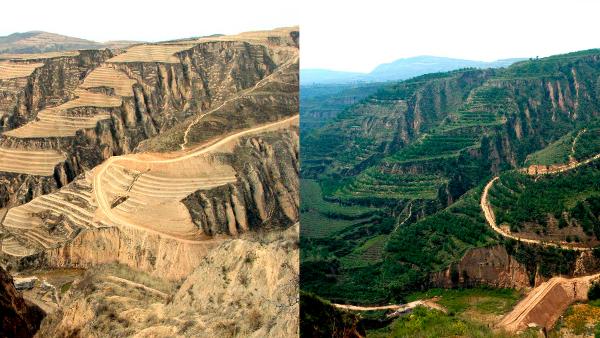Restoring China's Loess Plateau
Results
More than 2.5 million people in four of China’s poorest provinces – Shanxi, Shaanxi and Gansu, as well as the Inner Mongolia Autonomous Region – were lifted out of poverty. Through the introduction of sustainable farming practices, farmers’ incomes doubled, employment diversified and the degraded environment was revitalized.
- Incomes doubled: People in project households saw their incomes grow from about US$70 per year per person to about US$200 through agricultural productivity enhancement and diversification.
- Natural resources were protected: Uncontrolled grazing, subsistence farming, fuel wood gathering and cultivation of crops on slopes had left huge areas of the Plateau devastated. The project encouraged natural regeneration of grasslands, tree and shrub cover on previously cultivated slope-lands. Replanting and bans on grazing allowed the perennial vegetation cover to increase from 17 to 34 percent.
- Sedimentation of waterways was dramatically reduced: The flow of sediment from the Plateau into the Yellow River has been reduced by more than 100 million tons each year. Better sediment control has reduced the risks of flooding with a network of small dams helping store water for towns and for agriculture when rainfall is low.
- Employment rates increased: More efficient crop production on terraces and the diversification of agriculture and livestock production have brought about new on-farm and off-farm employment. During the second project period, the employment rate increased from 70 percent to 87 percent. Opportunities for women to work have increased significantly.
- Food supplies were secured: Before the project, frequent droughts caused crops cultivated on slopes to fail, sometimes requiring the government to provide emergency food aid. Terracing not only increased average yields, but also significantly lowered their variability. Agricultural production has changed from generating a narrow range of food and low-value grain commodities to high-value products. During the second project period, per capita grain output increased from 365 kg to 591 kg per year.
- The project significantly contributed to the restructuring of the agricultural sector, the adjustment to a market-oriented economic environment and created conditions for sustainable soil and water conservation.
- Even in the lifetime of the project, the ecological balance was restored in a vast area considered by many to be beyond help.
- Terracing required the development of roads that facilitated the access of vehicles and farm equipment and labor to these areas. Sediment control and capture transformed previously unproductive land into valuable cropping areas, helped increase water storage for communities and agricultural use and reduced flood risk. Terraces have reduced labor inputs and allowed farmers to pursue new income-earning activities.

